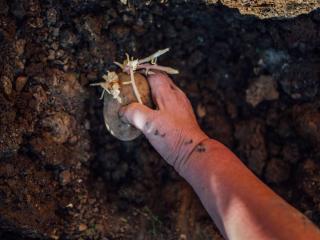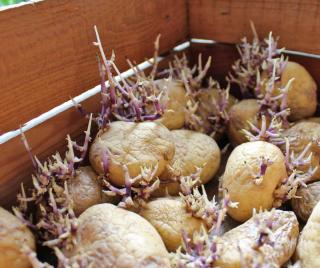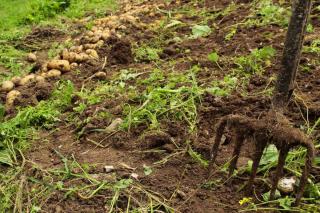

From planting to harvest, here are the practices that will help you grow beautiful potatoes.
Potato key facts
Name – Solanum tuberosum
Family – Solanaceae
Type – vegetable
Height – 1 ½ feet (50 cm)
Exposure – full sun
Soil – rather light, rich and not too damp
Harvest – from June to November, depending on the variety.
Planting potato tubers is easy, all the more so that it doesn’t really depend on the climate zone you live in.

In non-freezing areas or near the coast, you can even start mid-February, but it is wise to provide for cover such as cold frames or tunnel greenhouses in case frost spells hit.
→ Read also: Germinating potato at the right moment
Don’t hurry to plant because potatoes require that the ground beneath it be suitably warmed up first, since 50°F (10°C) at root level is needed for the potato to sprout.
 Wait for the tubers to have begun germinating before setting them in place.
Wait for the tubers to have begun germinating before setting them in place.As an alternative, you may want to try simply returning a large potato to the ground upon harvesting, mimicking what would happen in nature.
 This will save you time in spring since you won’t need to go through the entire germinating and sowing steps.
This will save you time in spring since you won’t need to go through the entire germinating and sowing steps.Exposure: Potato needs sun to develop well.
Although it is rather easy to care for, a potato plant benefits from being given attention to regularly in order to increase productivity and harvest.

Ridging means to build up a small mound at the base of the potato plant stems in order to secure the plant to the soil, protect it from wind, and let it grow at its best.
Potatoes are very sensitive to drought and do not cope well if the ground lacks water for too long.
Watering every evening is recommended when it is hot and that you see the leaves wilting. Avoid wetting the leaves as this might favor diseases such as mushrooms.
In order to remove any risk of the ground being too dry, it is recommended to mulch the base of the potato stems.

Once harvested, keep them in the dark in a cool, dry and ventilated place. A crate is perfect, since the openings help air circulate. Also great is a vegetable keeping silo.
Ha! Here they are grouped by flesh firmness, but there is an outlier that stands out for its color: the vitelotte noire, or ‘black vitelotte’
> Potato varieties with firm flesh
These are excellent for fries and for keeping together when preparing long-cooking stew.
‘Roseval’, ‘Belle de Fontenay’, ‘BF 15’, ‘Amandine’, ‘Charlotte’, ‘Bernadette’, ‘Chérie’, ‘Pompadour’ and the famous ‘Ratte du Touquet‘ are varieties that all boast a firm flesh.
> Potato varieties with mealy flesh
Perfect mashed and for other cooking uses.
‘Monalisa’, ‘Ostara’, ‘Désirée’, ‘Bintje’, ‘Manon’, ‘Estima’, ‘Apollo’ or ‘Resy’
> Summer harvest, from May to July
‘Belle de Fontenay’, ‘Monalisa’, ‘Manon’, ‘Ostara’, ‘Amandine’, ‘Bernadette’, ‘Charlotte’, ‘Chérie’, ‘Rosabelle’
> Fall harvest, from September to November
Most famous among a great many more, there is the ‘Nicola’, the ‘Bintje’ and the ‘Désirée’
Potatoes are nonetheless vulnerable to certain diseases and parasites that must be taken care of and treated quickly.
 Aphids – leaves lose their original color and roll themselves into cylinders.
Aphids – leaves lose their original color and roll themselves into cylinders.Together with tomatoes that are part of the same Solanaceae family, potatoes can also be attacked by a moth called the tomato pinworm or leafminer. This parasite can destroy up to 100% of a harvest.

Studies show that potato has been in use for over 8,000 years, but it is only after it arrived in Europe that cultivation spread across the world. Today, potatoes are grown in more than 150 countries and grow under virtually all climates.
Potato undoubtedly forms one of the most common staple foods in the world.
At planting time, after digging your rows to a depth of 4 to 6 inches (10 to 15 cm), place your tubers and cover them with the finest possible soil. Remove sticks, rocks and hardened clods.
<!–silent
–>